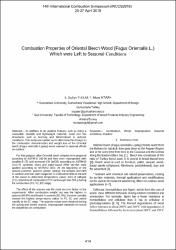Combustion Properties of Oriental Beech Wood (Fagus Orientalis L.) Which Left to Seasonal Conditions
Erişim
Attribution 3.0 United Statesinfo:eu-repo/semantics/openAccesshttp://creativecommons.org/licenses/by/3.0/us/Tarih
2018Erişim
Attribution 3.0 United Statesinfo:eu-repo/semantics/openAccesshttp://creativecommons.org/licenses/by/3.0/us/Üst veri
Tüm öğe kaydını gösterÖzet
In addition to its positive features such as being a renewable, durable and lightweight material, wood also has drawbacks such as burning and deformations in outdoor conditions. This study was carried out to determine the changes in the combustion characteristics and weight loss of the Oriental beech (Fagus orientalis Lipsky) wood exposed to seasonal effects on outdoor. For this purpose, after Oriental beech samples were prepared according to ASTM-E 160-50 and they were impregnated with tanalith-E (T) and wolmanit-CB (WCB) according to ASTM-D 1413-76, synthetic (Syn) and water-based (Wb) varnish were applied according to ASTM-D 3023. At the beginning of the seasons (summer, autumn, winter, spring), the samples were left to outdoor and then were subjected to combustion tests at the end of the season to determine temperature values, time of collapse (TC), total time of combustion (TTC) and weight loss (WL) during the combustion (FS, SC, EC stage). The effect of the seasons was the most decisive factor in the experiments. After combustion weight loss was the highest in autumn (94.9%) and lowest in summer (92.1%). Summer samples showed the highest temperatures values in FS, SC and cooled rapidly at the EC stage. The opposite values were obtained during the spring and winter seasons. Impregnated materials increased the weight loss on combustion.
Koleksiyonlar
Aşağıdaki lisans dosyası bu öğe ile ilişkilidir:



















